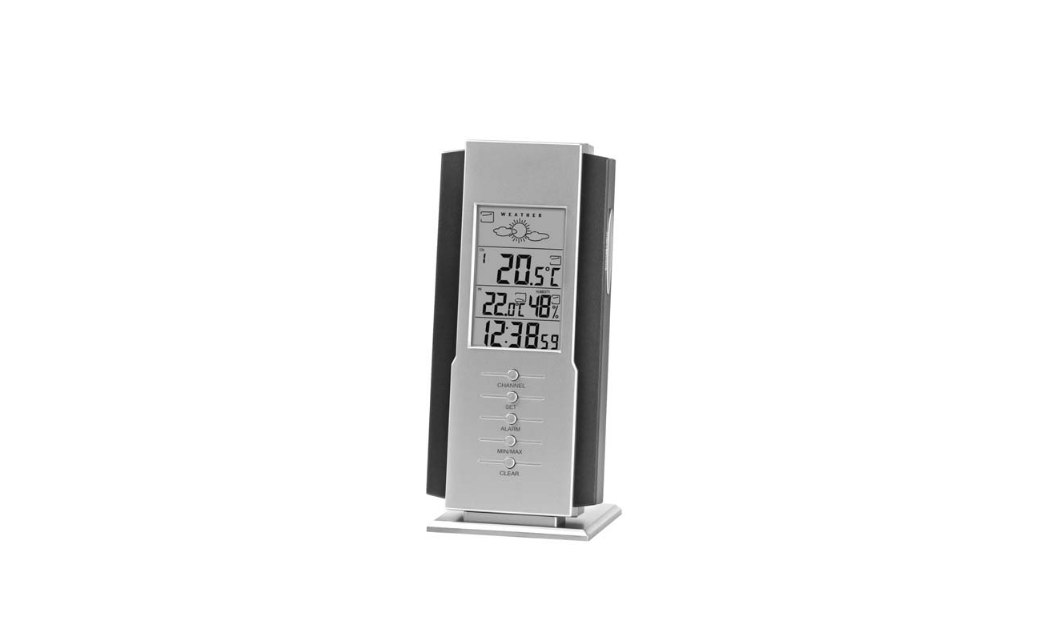ENVIRASTATION Weather Station
Wireless Operation
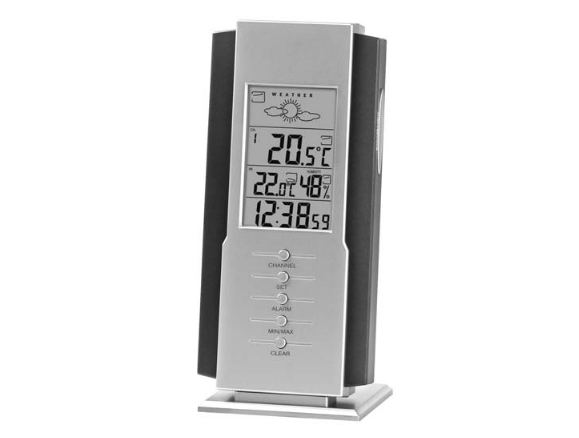
Instruction Manual
BEFORE YOU BEGIN
- IMPORTANT: Insert batteries into the home receiver unit first, then the remote sensor.
- Place the home unit as close as possible to the remote unit. This will help with synchronization between the remote sensor and the home unit.
- REMEMBER: Once you are ready to position your remote sensor and home unit, ensure that the distance is not outside the effective transmission range (100 feet). Some building materials and location of the home unit or remote sensor can affect transmission quality and range. Try various locations for best results.
BATTERY INSTALLATION
Home Receiver:
Lift off the battery cover on the back of the unit. Install 2 “AA” alkaline batteries included according to the polarity indicated. Close the battery cover.
Remote Sensor:
Remove the attached bracket stand. Loosen the 2 screws securing the battery cover with a small screwdriver and remove. Insert 2 “AA” alkaline batteries included according to the polarity direction indicated. Depress the C/F button to select either Centigrade or Fahrenheit temperature reading. Select the channel of the remote sensor by pushing “CH” push button. Always set the first sensor to channel 1, the 2nd to channel 2 and the 3rd to channel 3. Ensure the black gasket is properly seated in the housing and then replace the cover. Tighten the 2 screws to secure.
NOTE: There are no consumer serviceable parts.
(See Warranty section for contact information.)
GETTING STARTED
SETTING UP THE WIRELESS THERMOMETER
If you encounter any difficulties in setting up your wireless thermometer system, please contact Consumer Relations.
- For the first installation, always insert batteries into the home unit FIRST and then the remote sensor(s). (See BATTERY INSTALLATION section)
- Now enter the current weather conditions. Press “MAX/MIN” to select a weather condition (sunny, partially sunny, cloudy, rainy, stormy). Press “CLEAR” to confirm your selection. The built in barometer will automatically adjust to this setting.
- Your new RF Thermometer is built with security code technology, the home unit will learn the code of the first remote sensor and log it in as channel 1. Channel 2 and Channel 3 will be registered in the same way if additional sensors are used. This unit can monitor up to 3 separate sensors.
- Once a channel is registered, it will not accept any new sensors. However, registered channels can be erased by removing the batteries in the remote sensor or the home unit.
- When replacing batteries for the remote sensor– Remember to clear the corresponding channel of the home unit by removing the batteries. –OR– Select the respective channel of the sensor by pressing the CHANNEL button. Hold the CHANNEL button for 3 seconds to clear the registration.
- Press the Tx button on the back of remote sensor to verify the RF reception.
- It is recommended to test the units next to each other to ensure that both the remote sensor and home receiver are properly synchronized.
NOTE: Keep the remote sensor out of direct sunlight and rain. Do not mount on metal surface.
SETTING THE CLOCK & CALENDAR
- Hold “SET” button for 3 seconds to enter clock set.
- First, select 12 hour or 24 hour setting using the “ + , – ” buttons located on the back of the home receiver. Press “SET” button to confirm your selection.
- Select Year – Use the “ + , – ” buttons located on the back of the home receiver to adjust year setting. Press “SET” button to confirm your selection.
- Select Month – Use the “ + , – ” buttons located on the back of the home receiver to adjust month setting. Press “SET” button to confirm your selection.Now you will select the calendar settings
- Select Day – Use the “ + , – ” buttons located on the back of the home receiver to adjust day setting. Press “SET” button to confirm your selection.
- Select Hour – Use the “ + , – ” buttons located on the back of the home receiver to adjust hour setting. Press “SET” button to confirm your selection.
- Select Minute – Use the “ + , – ” buttons located on the back of the home receiver to adjust minute setting. Press “SET” button to confirm your selection.
- World Time Offset – Use the “ + , – ” buttons located on the back of the home receiver to adjust “World/Time Offset”. Press “SET” button to confirm your selection.
WORLD TIME FUNCTION
You can view the world time by pressing “SET” button, “World” on the LCD will be shown.
FAHRENHEIT/CENTIGRADE SELECTION
You can now select either Fahrenheit or Centigrade temperature readings. Hold the max/min button for 3 seconds to toggle between Centigrade or Fahrenheit readings.
SETTING ALARM TIME
This unit features two alarms (Alarm 1 and Alarm2). To select one press the “AL” button. Your selection will be shown on the display. To enter alarm time:
- Hold the “AL” button for 3 seconds. Press “ + , – “ to enter the desired Hr/ Min values and press “AL” to confirm setting.
- To view alarm time – Press “AL” button. Alarm time will display for 5 seconds and then resume to normal clock thereafter.
- The home receiver will provide either a daily alarm, which last for 2 minutes or a snooze mode where the alarm will repeat every 5 minutes until manually cleared (see SNOOZE/LIGHT section below).
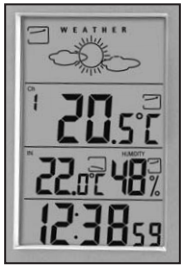
SNOOZE/ LIGHT
- Press the “SNOOZE/ LIGHT” button (Zz/ light icon button) for an extended backlight.
- In snooze alarm mode, press this button to trigger a repetitive snooze alarm.
- When normal alarm mode is selected, press the “SET”, “ALERT”, “+” or “–” buttons to turn off alarm for one day.
MAX/ MIN MEMORY SETTINGS
- Press ”MAX/ MIN“ button to view the maximum values for 5 seconds. Press again to view the minimum values.
- To clear the memory record, press “CLEAR” while the respective values displaying on screen.
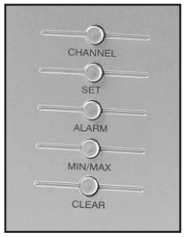
TEMPERATURE, PRESSURE AND HUMIDITY TREND INDICATORS:
You will see one of 3 icons;
![]()
will indicate Rising readings if it changes more than 1 degree or 1% relative humidity in an hour
![]()
will indicate Steady readings
![]()
will indicate Falling conditions if it is more than 1 degree 1% relative humidity in an hour
These readings are refreshed every hour.
WEATHER FORECAST WITH STORM ALERT
The built-in sensor will read the atmospheric pressure and calculate the weather conditions of the next 12 hours. These conditions will be displayed as; Sunny, Partial Sunny, Cloudy, Rainy, Stormy, Icy at the top of the LCD display.
OFFSETTING AIR PRESSURE FOR WEATHER FORECAST
To ensure accurate weather forecast under different altitude situations, you should first enter the existing weather condition manually. Press the “MAX/MIN” button to select the current conditions. Press “CLEAR” to confirm. The home unit will ask you to enter the existing weather condition right after installing batteries for the first time.
After the initial step or in case the weather forecast deviates from the existing conditions, you can still recalibrate the unit.
- Hold “CLEAR” button for 3 seconds to enter the pressure offset mode. The weather icon will flash.
- Select the existing weather condition by pressing “MAX/MIN” button.
- Press “CLEAR” to confirm and exit. 4. The unit is now calibrated to the existing pressure and weather conditions.
LOW BATTERY INDICATION
Low battery indication is available for the home receiver and the remote sensor. Replace the batteries and follow the setup procedure as mentioned in this instruction manual.
MOUNTING INSTRUCTIONS
Both the Home Unit and Remote Sensor come with a table stand or they can be wall mounted.
Table Top –
For the home unit, simply attach the stand provided.For the remote sensor, simply fold out the attached stand from the mounting bracket.
Wall Mounting –
For the Home Unit – Remove the table top stand from the bottom of the unit. Fix a screw (not included) into the desired wall and place the home unit onto the screw using the back side hanging hole.
For the Remote Sensor – Fix two screws (not included) into the desired hanging location using the mounting bracket holes on the remote sensor as a template. Ensure that the screws are placed vertically (in a straight line up/down) along the surface and that there is proper distance between each screw to hang the mounting bracket. Align the hanging holes of the mounting bracket with the two screws and place unit onto the screws.
MAINTENANCE AND CARE INSTRUCTIONS
- Extreme temperatures, shock or areas of unusual vibration should be avoided to prevent damage to the units.
- Clean the units using only a soft, damp cloth to wipe. Do not use solvents, abrasives, detergents or other strong cleaning agents. After cleaning, wipe surfaces with a dry cloth.
- Do not submerge units in water or other liquids.
- Do not subject the units to extremely severe temperatures – DO NOT PLACE UNITS INTO OVENS, FREEZERS or MICROWAVE UNITS.
NOTE: Opening the housing (other than the battery compartment) of either the Remote Sensor or the Home Unit will invalidate your warranty. Do not attempt to repair this unit – There are no consumer serviceable parts.
TROUBLE SHOOTING
ndoor and Outdoor temperatures do not match when placed next to each other –
Each sensor is manufactured to be +/- 1 degree in accuracy under normal conditions. So it is possible to have up to two degrees difference shown on the separate temperature sensors (one could be “+1 degree” and the other “-1 degree”. Additionally, the calibration curve is different between the two units because of the greater temperature range of the outdoor sensor. Errors are usually noted on the extreme ends of the temperature ranges.
Base unit is not accepting remote transmissions –
The units may not be properly synchronized or the batteries may need to be replaced. See “SETTING UP THE WIRELESS THERMOMETER” section beginning on page 2 of the instructions for detailed instructions. With the two units next to each other, attempt synchronization. Remember to always place the remote sensor within the effective transmission range and away from large metal surfaces.
What is the recommended battery type?
Your units will come with 4 “AA” alkaline batteries (2 “AA” batteries required for each unit). We recommend using only alkaline batteries for replacements.
Where can I mount the remote sensor?
To get accurate readings and to prolong the life of your sensor, we recommend that you mount it out of direct sunlight and rain. Fog and mist will not affect the sensor, but large volumes of soaking rain may. To guard against this, we recommend that you mount it under the eve of your house, your garage or any other suitable place that will keep it out of direct sun and rain.
SPECIFICATIONS
Range of temperature/humidity measurement:
Indoor temp : +23 F to +122 F (-5 C to + 50 C)Indoor humidity: 25% to 99% RHRemote sensor: -4 F to +140 F (-20 C to +60 C)Channel: max. 3 remote sensorsTransmission: max. 100 ft. (30 m) open area, RF434 MHzResolution: 0.1 degree for temperature, 1% RHClock: Quartz precision +/- 30 sec/monthBatteries: AA x 2 pcs for main unit, AA x 2 pcs for remote sensorBattery Life: 12 months (approx.) Alkaline batteries recommended.
Modifications not authorized by the manufacturer may void users authority to operate this device.
Note: This equipment has been tested and found to comply within the limits for a Class B digital device, pursuant to Part 15 of the FCC Rules. These limits are designed to provide reasonable protection against harmful interference in a residential installation. This equipment generates, uses and can radiate radio frequency energy and, if not installed and used in accordance with the instructions, may cause harmful interference to radio communications. However, there is no guarantee that interference will not occur in a particular installation. If this equipment does cause harmful interference to radio or television reception, which can be determined by turning the equipment off and on, the user is encouraged to try to correct the interference by one or more of the following measures:
- Reorient or relocate the receiving antenna.
- Increase the separation between the equipment and receiver.
- Connect the equipment into an outlet on a circuit different from that to which the receiver is connected.
- Consult the dealer or an experienced radio/TV technician for help.
Name and Functions of Buttons:
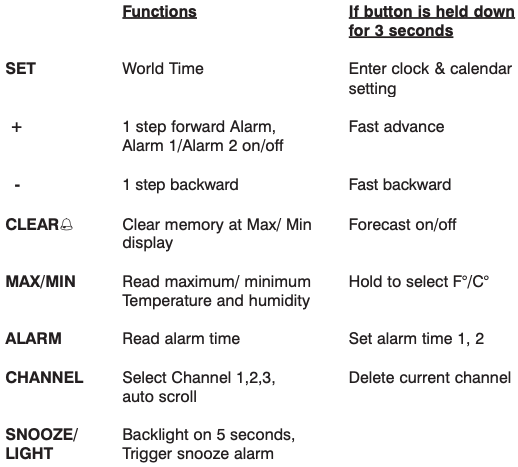
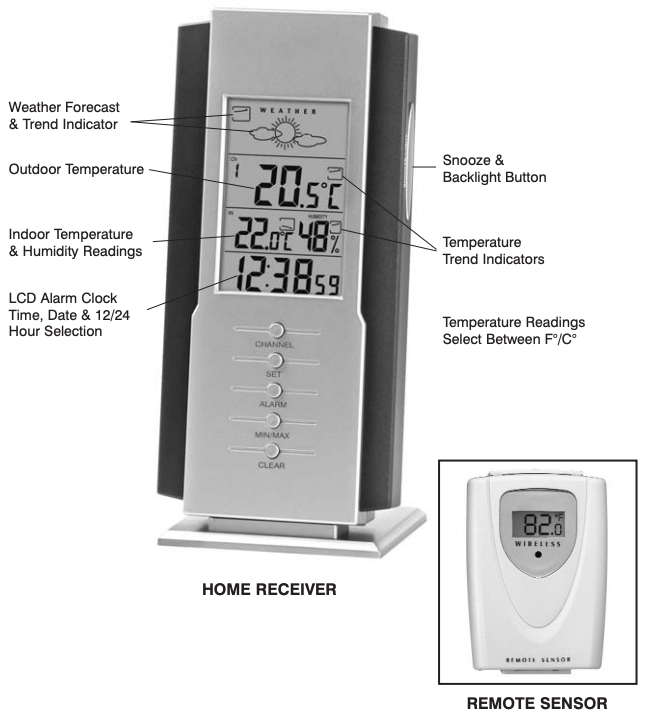
Homedics DWS-210 ENVIRASTATION Weather Station Wireless Operation Instruction Manual and Warranty Information – Homedics DWS-210 ENVIRASTATION Weather Station Wireless Operation Instruction Manual and Warranty Information –
[xyz-ips snippet=”download-snippet”]

